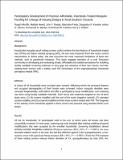Browsing Life sciences and Bio-engineering by Subject "Malaria"
Now showing items 1-10 of 10
-
Antimalarial potential and phytochemical composition of fractions of Lippia kituiensis Vatke (Verbenaceae) growing in Northern Tanzania
(Journal of Medicinal Plants Research, 2020-08-31)Despite past decades of steady advances in the fight against Malaria, statistics show that the disease is still a threat to human health. Previous successes in the development of antimalarial drugs from medicinal plants ... -
Comparison of cone bioassay estimates at two laboratories with different Anopheles mosquitoes for quality assurance of pyrethroid insecticide-treated nets
(Springer Nature., 2022-07-07)ckground: Quality assurance (QA) of insecticide-treated nets (ITNs) delivered to malaria-endemic countries is con ducted by measuring physiochemical parameters, but not bioefcacy against malaria mosquitoes. This study ... -
Cone Bioassays Provide Reproducible Bioefficacy Estimates with Different Anopheline Mosquitoes and Can Be Used for Quality Assurance of Pyrethroid Insecticide Treated Nets
(Research Square, 2022-01-24)Background Quality assurance (QA) of insecticide-treated nets (ITNs) delivered to malaria-endemic countries is conducted by measuring physiochemical parameters, but not bioecacy against malaria mosquitoes. The cone ... -
Effects of sample preservation methods and duration of storage on the performance of mid-infrared spectroscopy for predicting the age of malaria vectors
(BMC, 2022-08-06)Background Monitoring the biological attributes of mosquitoes is critical for understanding pathogen transmission and estimating the impacts of vector control interventions on the survival of vector species. Infrared ... -
Genetic diversity of Plasmodium falciparum reticulocyte binding protein homologue-5, which is a potential malaria vaccine candidate: baseline data from areas of varying malaria endemicity in Mainland Tanzania
(BioMed Central, 2025-01-27)Background The limited efficacy of the two recently approved malaria vaccines, RTS,S/AS01 and R21/Matrix- M™, highlights the need for alternative vaccine candidate genes. Plasmodium falciparum Reticulocyte Binding Protein ... -
In starvation, a bone can also be meat”: a mixed methods evaluation of factors associated with discarding of long-lasting insecticidal nets in Bagamoyo, Tanzania
(Springer Nature., 2022-03-24)Background: Between 2000 and 2019, more than 1.8 billion long-lasting insecticidal nets (LLINs) were distributed in Africa. While the insecticidal durability of LLINs is around 3 years, nets are commonly discarded 2 years ... -
Long-lasting insecticidal nets retain bio-efficacy after 5 years of storage: implications for malaria control programmes
(Springer Nature, 2020-03-14)Background: Long-lasting insecticidal nets (LLINs) are the most sustainable and efective malaria control tool currently available. Global targets are for 80% of the population living in malaria endemic areas to have access ... -
Participatory Development of Practical, Affordable, Insecticide-Treated Mosquito Proofing for a Range of Housing Designs in Rural Southern Tanzania
(Research Square, 2022-02)Background Insecticidal mosquito-proof netting screens could combine the best features of insecticide treated nets (ITNs) and indoor residual spraying (IRS), the two most important front line vector control interventions ... -
Ribosomal/nucleolar stress induction regulates tert-Butyl hydroperoxide (tBHP) mediated oxidative stress in Anopheles gambiae midguts.
(BMC Research Notes, 2019-03-29)Objective: A fundamental understanding of redox homeostasis in Anopheles gambiae midgut cells under different oxidative conditions is missing. Such knowledge can aid in the development of new malaria transmission-blocki ... -
Risk of Aedes-borne diseases in and around the Tanzanian seaport of Tanga despite community members being more concerned about malaria
(BioMed Central, 2024-12-18)Background Increased global trade, while beneficial economically, can also increase the spread of vector-borne diseases, particularly those transmitted by Aedes mosquitoes spreading via trade routes. Given the heightened ...










